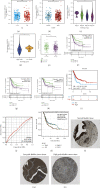Downregulation of PTCD1 in Bladder Urothelial Carcinoma Predicts Poor Prognosis and Levels of Immune Infiltration
- PMID: 35799606
- PMCID: PMC9256401
- DOI: 10.1155/2022/1146186
Downregulation of PTCD1 in Bladder Urothelial Carcinoma Predicts Poor Prognosis and Levels of Immune Infiltration
Abstract
Pentatricopeptide repeat domain 1 (PTCD1) was reported to regulate mitochondrial metabolism and oxidative phosphorylation. However, the effect and mechanism of PTCD1 in the development of bladder urothelial carcinoma (BLCA) remain unclear. The databases from The Cancer Genome Atlas (TCGA) and Human Protein Atlas (HPA) were used to analyze the expression changes, clinical features, and prognostic values of PTCD1. A nomogram was built to predict the prognostic outcomes of BLCA cases. The potential genes interacting with PTCD1 were explored by Weighted Gene Coexpression Network Analysis (WGCNA). The estimation of associations between PTCD1 and tumor mutations, tumor immunities, and m6A methylations was performed. The study found that the gradual decrease of PTCD1 expression was observed with the increase of stage and grade. Low PTCD1 expression was greatly correlated with higher pathological stage, N stage, and poor prognosis in TCGA cohorts; interestingly, low-grade BLCA cases all exhibited high expression of PTCD1. HPA database analysis implied that the expression of PTCD1 protein in BLCA was lower than that in normal bladder tissue, and the protein expression of PTCD1 in high-grade BLCA was lower than that in low-grade BLCA. Multivariate Cox regression analysis indicated that PTCD1 may serve as an independent factor influencing prognosis of BLCA. Mechanistically, PTCD1 played a regulatory role in BLCA progression through multiple tumor-related pathways containing PI3K-Akt signaling, ECM-receptor interaction, oxidative phosphorylation, and extracellular matrix organization. WGCNA reported that PTCD1 had a strong positive correlation with POLR2J, ZNHT1, ATP5MF, PDAP1, BUD31, and COPS6. Besides, the mRNA expression of PTCD1 was negatively associated with immune cells' infiltrations, immune functions, and checkpoints, especially with some m6A methylation regulators in BLCA. In sum, downregulation of PTCD1 expression may be involved in the development of BLCA and remarkably correlated with poor prognosis. Meantime, it showed an influence in immune cell infiltration and may serve as an agreeable prognostic indicator in BLCA.
Copyright © 2022 Zhongbao Zhou et al.
Conflict of interest statement
The authors have no conflicts of interest to declare regarding the publication of this paper.
Figures









References
-
- Kaseb H., Aeddula N. R. Bladder Cancer. StatPearls. Treasure Island (FL) St. Petersburg, FL, USA: StatPearls Publishing LLC; 2022.
LinkOut - more resources
Full Text Sources

